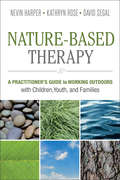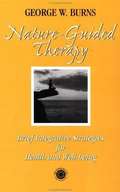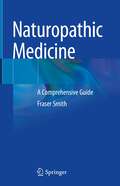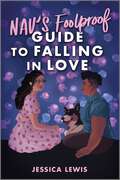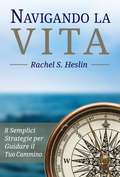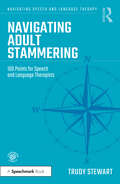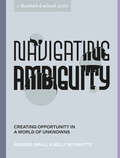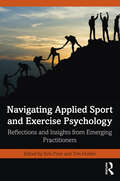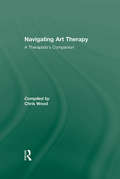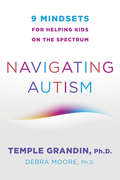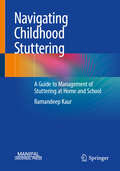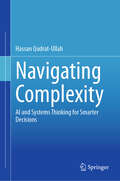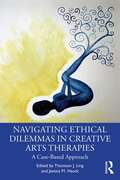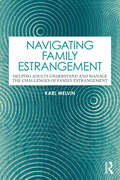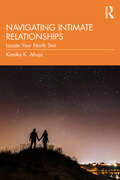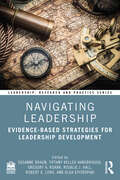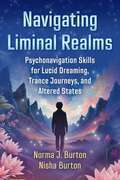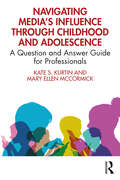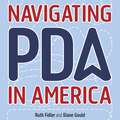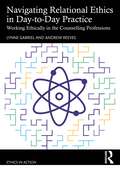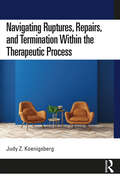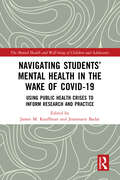- Table View
- List View
Nature-Based Therapy: A Practitioner's Guide to Working Outdoors with Children, Youth, and Families
by Nevin Harper Kathryn Rose David SegalTake advantage of nature’s therapeutic benefits with this guide for counselors, therapists, and educators who work with children, youth, and families.The number of people seeking help for a wide range of mental health concerns is growing at an alarming rate. Unplugging from technology and reconnecting with the web of life is a powerful antidote to the anxiety and stress that tend to exacerbate so many of our mental health struggles.Nature-Based Therapy addresses the underlying disconnection between humans and their ecological home, exploring theories and therapeutic practices designed for children, youth, and families, including:Developing sensory awareness of outer and inner landscapesNavigating risk in playCase examples with a diverse range of settings, intentions, and interventions
Nature-Guided Therapy: Brief Integrative Strategies for Health and Well-Being
by George W. BurnsIt takes us on a cross-cultural journey into traditional healing disciplines, such as ethno-medicine, sociobiology, and anthropology. By examining clinical data, empirical scientific investigations, and anecdotal accounts, Dr. George Burns helps point the way to healing benefits of a balanced relationship with the environment.
Naturopathic Medicine: A Comprehensive Guide
by Fraser SmithThis book offers comprehensive coverage of naturopathic medicine. The principles and values of this profession are already clearly stated (i.e., Find and Treat the Cause; Treat the Whole Person, etc.), but few are the textbooks that provide a clear exposition of what the approach is that differs from what is described as conventional or allopathic medicine. The toolkit – herbs or nutrients – then becomes the defining feature, but this is not the most important attribute. To paraphrase the historian of medicine Harris Coulter – in this approach the body reacts creatively to stressors – and the Empirical school or natural medicine approach is more focused on supporting adaptive responses than suppressing symptoms. Or to put it another way, naturopathic physicians certainly do things to ameliorate symptoms, but their real interest is to discern what disturbances to the determining factors of health lead to imbalances, physiological dysfunction, and are generating the symptoms. This is not an attempt to argue that all health issues can get better on their own or that conventional medical interventions aren’t capable of producing stellar outcomes. Conventional medicine holds great value, but there remains a concurrent need for a naturopathic approach that helps rebuild the body.There is a need for an approach in medicine that works to support adaptive responses of the body, reduce maladaptive responses, address determining factors of health, and sometimes create temporary homeostasis with agents such as drugs (or certain natural medicines) can play to maintain life when the body’s healing responses are insufficient. This book takes this approach and begins by examining what health is and then what states lead to disease. In terms of the basis of disease states, the book teaches about how the lack of coordination in the body’s bioregulatory systems (hormones, nervous system, cell signaling) can lead to disease, as well as the impact of irreversible degeneration, genetic damage, chronic stress, etc. The book takes the reader to some of the more common and well described reasons for these states of dysfunction, including the body’s inability to process environmental toxins and disruptions to the human microbiome. The book then teaches how to assess a patient, and how various natural therapies impact root causes of disease, the long term consequences, and the various clinical manifestations.The book then takes a systems approach – cardiovascular, pulmonary, etc. This is where most books on the subject start, but instead of breaking out a number of conditions and giving protocols of diet, supplements, herbs etc., the author examines how to restore stability and function to that system. There is in depth coverage of how to confront degenerative processes that make self-healing far more challenging, or perhaps not entirely attainable. The application of the model of healing outlined in previous chapters is applied to each system. Special topics are then covered, ranging from lifespan/primary care considerations to the role of research, the rise of advanced data analytics as decision assistance, to the environmental, cultural, and global determinants of health. Each chapter will additionally include tables that summarize key diagnosis or treatment points, arrayed in an order that reflects the model presented in the book.This is an ideal guide for students in naturopathic medicine, as well as physicians and medical professionals looking to learn more about this field aimed towards maximizing patient resilience.
Natürlich mehr leisten!: Von Sportlern lernen - als Führungskraft erfolgreich sein, gesund bleiben
by Jana Leidenfrost Andreas SachsErfolgreiche Menschen rufen jederzeit, punktgenau und in vielfältigen Situationen ihre beste Leistung ab. Doch um die Leistungsfähigkeit auch langfristig zu bewahren und dabei gesund zu bleiben, bedarf es einer guten Balance aus Leistung und Regeneration. In der westlichen, stark aufgabenorientierten Wirtschaftswelt ist diese Erkenntnis bisher wenig umgesetzt - entsprechend nehmen Burnout u.a. psychische Krisen stetig zu. Im Spitzensport ist sie dagegen seit langem ein Erfolgsfaktor: Denn es gehört zu unseren ganz menschlichen Potenzialen, auf natürliche Weise "mehr" zu leisten und dabei auf allen Ebenen fit zu bleiben - vorausgesetzt, der "Trainingsplan" stimmt! Die Autoren dieses Buches wissen das aus eigener Erfahrung, denn sie sind sowohl als Leistungssportler als auch Unternehmensberater erfolgreich. Hier geben sie neue Impulse für eine erfolgreiche Führungsarbeit und ein positives Leistungsverständnis, indem sie Erfolgsfaktoren, Trainingsmethoden und positive Bilder aus dem Sport auf den Wirtschaftsbereich übertragen. - Dabei entsteht eine neue Sicht auf Themen wie Motivation, innerer Antrieb, Vision und Zielbildung, Flow oder Teamgeist. Im Detail vermittelt dieses Buch Haltungen, Techniken und Trainingspläne für das Management der eigenen Energie sowie der Team- und Organisationsperformance. Letztlich liefert es damit einen Beitrag zur aktuellen Burnout-Diskussion und eröffnet neue Möglichkeiten der Potenzialentfaltung. Ein Buch für alle, die auf gesunde Weise Leistung bringen, Mitarbeiter entsprechend fördern und ihre Organisationen nachhaltig gestalten möchten.
Nav's Foolproof Guide to Falling in Love
by Jessica LewisNav knows how to flirt, but she also knows love is a messy losing proposition. As proof, her best friend, Hallie, is constantly getting her heart broken. And when Hallie goes to her boring academic camp this summer, Nav won&’t be there to protect her for the first time in their lives. So when shy new girl Gia asks Nav for help getting Hallie&’s attention, Nav finds a way to make it work for her. In exchange for lessons in romance, Gia, whose mom runs the camp, will help get Nav a spot there. And if her coaching works, maybe Hallie can date someone who will treat her right for a change. Except…Gia&’s not just bad at flirting, she&’s terrible. She&’s too anxious to even speak to Hallie, never mind date her. Training Gia quickly becomes a disaster. Worse, Gia&’s every awkward joke and catastrophic fake date makes Nav like Gia a little bit more…and not in a friend way. Which puts a really, really big wrench in Nav&’s plans. As Nav&’s feelings change, she&’ll have to decide what&’s more important: sticking to her plan for the perfect summer or taking a chance on learning more about love than she ever expected.
Navegando a Vida: 8 Estratégias Simples para Guiar Seu Caminho
by Rachel S. Heslin Alessandra GuettiEstá cansado de se sentir puxado em várias direções, sem saber qual caminho seguir? Você sabe que está aqui neste planeta para causar um impacto, mas parece haver tantas possibilidades e oportunidades (e responsabilidades e obrigações!) – como saber se está indo na direção certa? Felizmente, existem habilidades que você pode desenvolver para saber quais opções te movem na direção de seus sonhos - e quais não te levam a lugar algum. Este livro é para você, se você é: •Muito inteligente, mas capaz de “pensar demais” sobre tudo •Altamente sensível às emoções e desejos dos outros, às vezes ao ponto de não ter certeza onde você termina e o outro começa •Extremamente criativo •Empenhado em fazer do mundo um lugar melhor •Possuidor de uma visão – mesmo que seja apenas uma sensação de ser diferente de como você está agora – embora não tenha certeza de como chegar lá ou fazer acontecer •Capaz de ver potencial em uma infinidade de possibilidades, mas talvez hesitante na hora de agir, por medo de perder todas as outras possibilidades que você não escolheu Se você se identifica com qualquer uma dessas descrições, o livro Navegando a Vida irá te mostrar como: •Identificar a diferença entre seus sonhos e os objetivos de outra pessoa •Equilibrar a criação da sua Grande Visão com a identificação dos seus Próximos Passos •Aprender a manter a sua força mesmo quando não esteja muito confiante … e muito mais.
Navigando la Vita: 8 Semplici Strategie per Guidare il Tuo Cammino
by Ciro Cibelli Rachel S. HeslinTi senti spinto in così tante direzioni che non sai quali intraprendere? E se potessi sviluppare un modo per "sapere" che stai facendo sempre la cosa giusta? Lo sai che sei qui a questo mondo per dare un impatto, ma sembrano esserci così tante possibilità e opportunità (e responsabilità e obblighi!): come puoi essere sicuro che stai percorrendo la strada giusta? Fortunatamente, ci sono abilità che puoi sviluppare per imparare quali scelte ti muovano verso la direzione dei tuoi sogni, e quali invece ti fanno solo girare in tondo. Questo libro fa al caso tuo se sei: - Molto intelligente, ma a volte "pensi troppo" - Molto sensibile alle emozioni e desideri altrui, spesso al punto che non sei sicuro/a di quando si fermino i tuoi e comincino quelli degli altri - Molto creativo/a - Interessato/a a rendere il mondo un posto migliore - In possesso di una Visione -- anche se è solo una sensazione di sentirsi diversi da dove si è adesso -- ma non sai come raggiungerla o farla avverare. - In grado di vedere il potenziale in numerose possibilità, ma esiti ad agire per paura di poter perdere tutte le altre possibilità che non hai considerato. Se ti rispecchi in una di queste descrizioni, Navigando la Vita ti mostrerà come: - Sapere la differenza tra i tuoi sogni e quelli degli altri - Creare la tua Grande Visione decidendo le prossime mosse da fare - Imparare come mantenere la grinta, anche quando non te la senti ... e molto altro
Navigating Adult Stammering: 100 Points for Speech and Language Therapists (Navigating Speech and Language Therapy)
by Trudy StewartThis book, the first in an exciting new series, provides speech and language therapy students and newly qualified and beginning stammering specialists with 100 key points that will help form a strong foundation for their work supporting adults and teenagers who stammer. Composed of practical, relevant and useful advice from an experienced clinician, chapters break advice down into sections which include information about the therapeutic relationship, therapeutic approaches and signposts to further resources. Throughout the book, comments from stammering specialists describe what they wish they had known at the start of their careers. This book: Puts the person who stammers at the heart of therapy, following the clinical choices they might make Is written in an accessible style, designed to be dipped in and out of as required Draws on the experience of therapists working with those who stammer Full of advice and guidance to support effective practice, this is an essential resource for anybody new to this client group.
Navigating Ambiguity: Creating Opportunity in a World of Unknowns (Stanford d.school Library)
by Stanford d.school Andrea Small Kelly SchmutteA thought-provoking guide to help you lean in to the discomfort of the unknown to turn creative opportunities into intentional design, from Stanford University's world-renowned d.school.&“Navigating Ambiguity reminds us not to run from uncertainty but rather see it as a defining moment of opportunity.&”—Yves Béhar, Founder and CEO, fuseprojectA design process presents a series of steps, but in real life, it rarely plays out this neatly. Navigating Ambiguity underscores how the creative process isn&’t formulaic. This book shows you how to surrender control by being adaptable, curious, and unbiased as well as resourceful, tenacious, and courageous.Designers and educators Andrea Small and Kelly Schmutte use humor and clear steps to help you embrace uncertainty as you approach a creative project. First, they explain how the brain works and why it defaults to certainty. Then they show you how to let go of the need for control and instead employ a flexible strategy that relies on the balance between acting and adapting, and the give-and-take between opposing approaches to make your way to your goal.Beautiful cut-paper artwork illustrations offer ways to rethink creative work without hitting the usual roadblocks. The result is a more open and satisfying journey from assignment or idea to finished product.
Navigating Applied Sport and Exercise Psychology: Reflections and Insights from Emerging Practitioners
by Tim Holder Erin PriorIn recent years, more students have chosen to study sport and exercise psychology with a view to building careers as applied practitioners. While sport and exercise psychology master’s graduates leave university with the necessary theoretical knowledge to inform their practice, they are often left wanting to know more about creating and navigating a career within the field. Navigating Applied Sport and Exercise Psychology provides readers with an honest and contemporary insight into the work and experiences of trainees and early career practitioners. This book delves further into the more complex and nuanced experiences of being an applied practitioner. Using case studies and reflections, the chapters explore key topics including working within multi-disciplinary teams, maintaining ethics and integral practice during challenging conversations and supporting mental health in high-performance environments. Written by trainees and early career practitioners, this book is vital reading for students, early career practitioners, and anyone interested in sport psychology. Erin Prior is a BPS Chartered, HCPC registered Sport and Exercise Psychologist. As an applied practitioner, Erin works with a range of individuals, teams, and organisations across various sports. Alongside her applied practice, Erin is completing her PhD which is focused on athlete mental health, at Loughborough University. Tim Holder, PhD, is an HCPC Registered Sport and Exercise Psychologist, BPS Chartered and a BASES Fellow. He is an applied sport psychology consultant and supervisor to students working towards practitioner status in the UK. Tim is the Programme Leader for the MSc in Applied Sport Psychology at the University of Winchester, UK.
Navigating Art Therapy: A Therapist’s Companion
by Chris WoodFrom Art-making as a Defence to Works of Art, this anthology will help you navigate your way through the ever growing world of art therapy. Art therapy is used in an increasing range of settings and is influenced by a range of disciplines, including psychotherapy, social psychiatry, social work and education. Navigating Art Therapy is an essential companion for both seasoned art therapists and those new to the field as it offers a comprehensive guide to key terms and concepts. With contributions from art therapists around the world, entries cover: forms of interpretation processes of adaptation history of art therapy the inspiration provided by artworks and popular culture This book is an ideal source of reference as the concise, cross-referenced entries enable easy navigation through ideas and terms integral to the discipline. As such, it is invaluable for anyone working in the art therapy field.
Navigating Autism: 9 Mindsets For Helping Kids on the Spectrum
by Temple Grandin Debra MooreEmpowering strategies for anyone who works with children and teens on the spectrum. International best-selling writer and autist Temple Grandin joins psychologist Debra Moore in presenting nine strengths-based mindsets necessary to successfully work with young people on the autism spectrum. Examples and stories bring the approaches to life, and detailed suggestions and checklists help readers put them to practical use. Temple Grandin shares her own personal experiences and anecdotes from parents and professionals who have sought her advice, while Debra Moore draws on more than three decades of work as a psychologist with kids on the spectrum and those who love and care for them. So many people support the lives of these kids, and this book is for all of them: teachers; special education staff; mental health clinicians; physical, occupational, and speech therapists; parents; and anyone interacting with autistic children or teens. Readers will come away with new, empowering mindsets they can apply to develop the full potential of every child.
Navigating Childhood Stuttering: A Guide to Management of Stuttering at Home and School
by Ramandeep KaurThis book serves as a guide, covering stuttering from its development and treatment to relapse and recovery. In addition to discussing types and prevalence, it also explores various treatment techniques for children. The chapters address the emotional aspects of stuttering and integrate elements from speech therapy, cognitive and behavioral therapy, education, and occupational therapy, ensuring holistic care and understanding for both patients and caregivers. The book is supplemented with case studies of individuals who have overcome their stuttering. This book is relevant to occupational therapists, professionals, and students alike, offering insights and strategies for understanding, managing, and overcoming stuttering.
Navigating Complexity: AI and Systems Thinking for Smarter Decisions
by Hassan Qudrat-UllahThis book, “Navigating Complexity: AI and Systems Thinking for Smarter Decisions” delves into the integration of Artificial Intelligence (AI) and systems thinking to enhance decision-making in complex and dynamic environments. Aimed at professionals, researchers, and academics in fields such as management, healthcare, sustainability, and public policy, it provides a comprehensive exploration of how these two approaches can be synergistically employed. The main topics include the theoretical foundations of complexity science, the practical application of AI and systems thinking tools, and real-world case studies demonstrating their combined use. These topics are crucial as they address the need for advanced methodologies to navigate and manage the increasing complexity in modern decision-making scenarios. The book seeks to solve the problem of effectively managing complexity by offering innovative frameworks and models that integrate AI’s data-driven capabilities with systems thinking’s holistic approach. This integration is essential for improving decision-making processes across various domains, providing readers with actionable insights and tools to tackle contemporary challenges.
Navigating Environmental Attitudes
by Thomas A. HeberleinSolving environmental problems requires a scientific understanding of public attitudes. Like rocks in a swollen river, attitudes often lie beneath the surface-hard to see, and even harder to move or change. In Navigating Environmental Attitudes, Thomas Heberlein helps us read the water and negotiate its hidden obstacles, explaining what attitudes are, and how they change and influence behavior. Rather than necessarily trying to change public attitudes, we need to design solutions and policies with them in mind. He illustrates these points by tracing the attitudes of the well-known environmentalist Aldo Leopold, while tying social psychology to real-world behaviors throughout the book. Bringing together theory and practice, Navigating Environmental Attitudes provides a realistic understanding of why and how attitudes matter when it comes to environmental problems; and how, by balancing natural with social science, we can step back from false assumptions and unproductive, frustrating programs to work toward fostering successful, effective environmental action.
Navigating Ethical Dilemmas in Creative Arts Therapies: A Case-Based Approach
by Thomson J. LingNavigating Ethical Dilemmas in Creative Arts Therapies uses a case-based approach to provide practical guidance for practitioners on the skillful application of ethical decision-making in art therapy. The book introduces the DO ART model, an ethical decision-making model specific to the practice of art therapy. Walking readers through common areas of ethical dilemmas, chapters detail how art-making can be used to navigate the model, supporting the well-documented practice of art therapists engaging in art-making processes themselves. Topics covered include boundaries and confidentiality, assessment, storage and exhibition, materials, multicultural issues, technology in art therapy, working with vulnerable populations, supervision and training, and ethical research. Art therapists at all levels will find this book to be a necessary resource for their practice.
Navigating Family Estrangement: Helping Adults Understand and Manage the Challenges of Family Estrangement
by Karl MelvinFamily estrangement and the stigma attached to it are complex phenomena affecting a great number of people in various ways. In response, Navigating Family Estrangement offers a deep dive into the reality of being estranged in contemporary society.This practical guide looks at how to effectively help estranged adults achieve better outcomes from a variety of perspectives. The author explores the difficulties of working with estrangement, including professional roadblocks such as the six biases that prevent connecting with a client's experience. He delves into the unique seven-step Estrangement Inquiry Model that aims to provide important insight into a client's family history, map out the present estrangement dynamic, and highlight the types of interventions to support their needs. Combining research from a range of different fields with the author's decade of clinical experience, the book is supplemented with five comprehensive case studies to demonstrate the practical strategies that address estrangement challenges.This book offers a clear and collaborative approach to a topic that will be relevant for a range of professionals, including psychotherapists, psychologists, counsellors and social workers.
Navigating Intimate Relationships: Locate Your North Star
by Kanika K. AhujaThis book spotlights the complexities of relationships, drawing on theories that have guided relationship scholars, classic studies, and current research – juxtaposed with the current Indian milieu. While some believe that the study of interpersonal relationships lacks academic rigour, this book argues that relationships not only play a critical role in human behaviour and development but also are central to our well-being, happiness, and health.One of the first mainstream books in India to address relationships beyond the binary of man/woman, this volume presents an inclusive view of gender and sexuality, including non-heterosexual relationships. It also touches on multiple types of relationships in the 21st century, such as mixed families, singles, live-in, living apart together (LAT), role of dating apps, and so on.This book would be useful to students, researchers, and teachers of Psychology, Applied Psychology, Mental Health, Sociology, Family Studies, and other allied disciplines. It will be a useful guide for students to build and maintain relationships and practice positive relational attitudes, like self-acceptance, gratitude, and forgiveness. It will also be an equally indispensable resource for counsellors, researchers, practitioners in mental health, family caregivers, relationship counsellors, and professionals in related fields.
Navigating Leadership: Evidence-Based Strategies for Leadership Development (ISSN)
by Susanne Braun Olga Epitropaki Rosalie J. Hall Tiffany Keller Hansbrough Gregory A. Ruark Rosalie G. LordNavigating Leadership provides evidence-based tools and recommendations to develop your leadership successfully. The book integrates knowledge in the areas of leadership and followership from evidenced-based global research and translates the findings into suggestions for organizational best-practices.Am I leader? How can I grow as a leader? How am I doing as leader? How can I move on and let go of leadership? In a changing world of work, people are confronted with these questions about their leadership every day. This book considers such topics as reflecting on goals, impostorism, memory, experiencing meaningfulness at work , measuring leader performance and the challenge of leaving leadership, to offer ideas and answers to these questions of what it means to be a leader and how you can thrive on your own personal leadership journey. Each chapter provides a range of applied cases, tools and techniques, and critical commentaries to help uncover your leader identity, address personal challenges, and accelerate your leadership development.Addressing the persistent gap between research and practice in leadership and followership through research-practice translation, this is the ideal resource for professionals, at both an individual and organizational level, looking to support and increase leadership development. It will also appeal to scholars and students of leadership, followership, and leader identities.
Navigating Liminal Realms: Psychonavigation Skills for Lucid Dreaming, Trance Journeys, and Altered States
by Norma J. Burton Nisha Burton• Investigates drumming-induced trance states through shamanic journeying• Provides advanced lucid dreaming training, sharing techniques for inducing lucidity and skillfully navigating our inner cosmos• Explores the mindful use of psychedelics, offering guidance on setting intention, navigating the experience, and integrating insightsOFFERING TECHNIQUES from psychonauts ancient and modern, this profound guide helps you navigate consciously into the depths of the human psyche. Psychonavigation is the art of mindfully exploring the liminal realms of consciousness. This requires a map, a guide, and a clear intent, so one does not emerge overwhelmed and struggling with unexpected shadow material.Norma and Nisha Burton map the important connection between three gateways into the psyche&’s depths: lucid dreaming, shamanic drumming trance journeys, and ceremonial plant medicine journeys. With drumming-induced trance journeys, they explore the scientific effect on brainwave frequencies alongside consciousness teachings from indigenous cultures like the Sami of Norway and Huichol of Mexico. Their masterful approach to lucid dreaming transcends basic instruction, offering sophisticated techniques to not only summon but sustain lucidity and integrate suppressed parts of oneself. They explain how a mindful engagement with entheogens can be profoundly enhanced through these precursory mystical practices, creating a safe container for integration and meaning-making that honors the gravity of such experiences.With these skillful methodologies, ancient psycho-spiritual techniques meet ultra-current science to enable seekers to process and integrate profound encounters with expanded consciousness.
Navigating Media’s Influence Through Childhood and Adolescence: A Question and Answer Guide for Professionals
by Kate S. Kurtin Mary Ellen McCormickNavigating Media’s Influence Through Childhood and Adolescence moves through research and questions that are relevant to practicing pediatricians and therapists in their everyday practice. As we navigate post-pandemic life where screen time was unrestricted in most homes, this book has never been more important. Written by a pediatrician and a professor of media effects, this book is a vital resource for practicing mental health clinicians, counselors, psychologists, physicians, and students studying in those areas. Grounded in developmental theory, mass communication theory, current research, and acumen gained from years of clinical and teaching experience, this book gives professionals what they need to understand the colossal effect media is having on their patients. An aid to practitioners, this book is organized by developmental stage and matches specific questions related to media’s effects with explicit research-based recommendations and explanations. It is intended to be a quick resource guide for the busy professional.
Navigating PDA in America: A Framework to Support Anxious, Demand-Avoidant Autistic Children, Teens and Young Adults
by Ruth Fidler Diane GouldAlthough Pathological Demand Avoidance (PDA) has been a recognized autistic profile in the UK for some time, awareness is still growing in America. When parents first learn about it they talk about having a lightbulb moment of understanding their child better. Many described how, having found traditional parenting and behavioral techniques made things worse instead of better, they felt judged and alone. Teachers and school administrators also reported struggling to support their PDA students. The children, teens and young adults themselves were often left feeling misunderstood.The authors of this book explain PDA with an emphasis on promoting well-being both for PDA individuals and all those who support them. They provide a neurodiversity-affirming framework for supporting anxious, demand avoidant individuals across a range of settings and services. As awareness spreads across the pond, the compassion and clarity in this book will become a valuable guide to many.
Navigating Relational Ethics in Day-to-Day Practice: Working Ethically in the Counselling Professions (Ethics In Action)
by Andrew Reeves Lynne GabrielThe first in a new series on ethics in the counselling professions, Navigating Relational Ethics in Day-to-Day Practice contextualises the series and provides a practical ‘how to’ guide for bringing the theoretical concepts of ethics into practice. Lynne Gabriel and Andrew Reeves provide a compelling explanatory narrative on the importance of translating ethical concepts into meaningful pragmatic practice and practitioner tools. They set out key theories, concepts, and contemporary challenges in practice ethics, offering multiple lenses through which to make meaning of complex practice or risk scenarios and settings. Importantly, the book considers contemporary concepts associated with social justice including working in anti-oppressive ways. The chapters feature an array of engaging material, including a round table dialogue on working ethically in day-to-day practice, a ‘toolkit’ for working ethically across multiple contexts and presenting issues, and a rich collection of case examples from the authors’ lived experience.This text supports trainees and practitioners in taking ethical frameworks into their direct work with clients and in their wider role in practice.
Navigating Ruptures, Repairs, and Termination Within the Therapeutic Process
by Judy Z. KoenigsbergThis book explores the importance of the therapeutic relationship, the tensions or disagreements that may emerge during a therapy session, and how they can be repaired.Dr. Koenigsberg introduces a two-part transtheoretical, psycholinguistic model which focuses on the connection between ruptures and the termination phase of therapy, emphasizing the verbal and nonverbal nuances of language, to understand what is happening in the therapeutic alliance. With a reliance on psycholinguistic elements, this model can guide therapists who wish to reduce the premature termination of patients from therapy. Written in an accessible format, it provides case examples, including the patient’s and therapist’s inner experiences, and defines and describes the phases of therapy so that difficult transitions in the therapeutic process can be navigated with skill and compassion.This text is essential for providing early career as well as more seasoned therapists with excellent strategies to repair their therapeutic relationships with clients.
Navigating Students’ Mental Health in the Wake of COVID-19: Using Public Health Crises to Inform Research and Practice (The Mental Health and Well-being of Children and Adolescents)
by James M. Kauffman Jeanmarie BadarThis book highlights the effects of the COVID-19 pandemic on the mental health needs of children and adolescents in order to shed light on future practice and reform needed to better deal with the aftermath of such devastating events. The book identifies the conditions during any public health crisis that heighten the mental health needs of children and adolescents and suggests the reforms of mental health services needed to better meet the needs of children and youths during and following pandemics and other public health crises. Importance is placed not only on addressing the effects of COVID-19 but on anticipating and preparing for other public health disruptions to the lives of those who have not reached adulthood. Although mental health services in all settings are considered, special attention is given to the role of schools in providing for the mental health of children and adolescents and preparing for the mental health implications of future public health disruptions. The book will be of equal use to both students and researchers in the fields of mental health, well-being, and education as well as teachers, educational psychologists, social workers, and practitioners working in schools and communities to address students’ mental health needs. It will help readers better understand how and why COVID-19 was a negative influence on students’ mental health, and unpack how best to deal with the aftermath of the pandemic.
